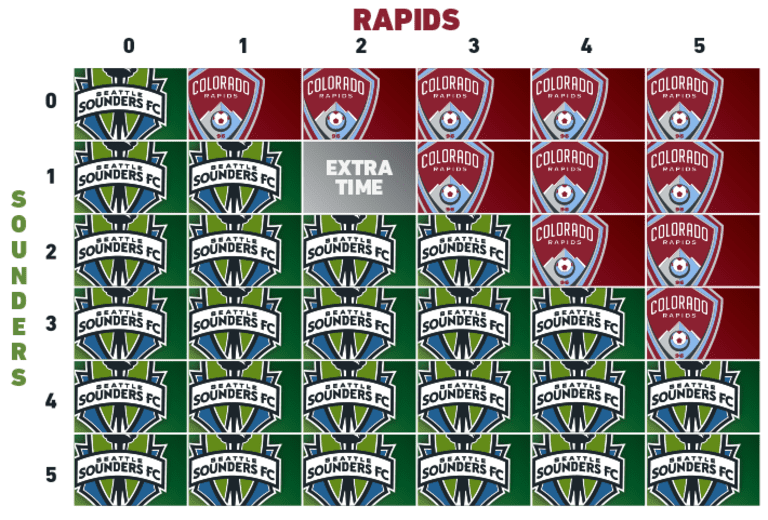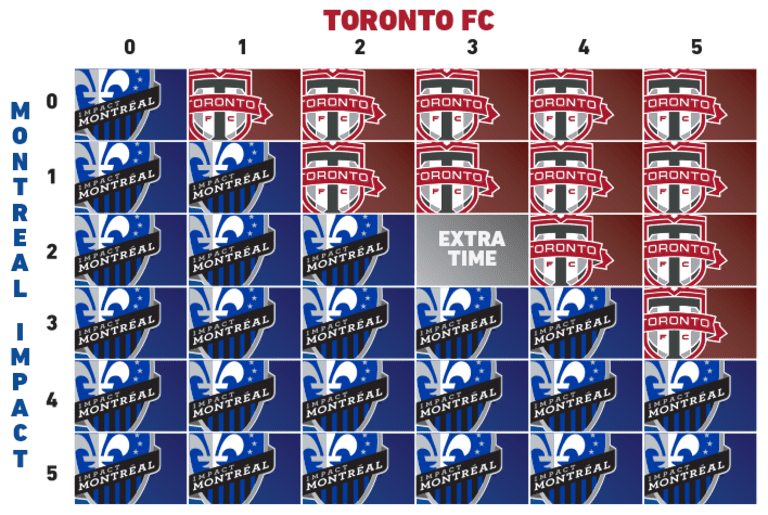Toronto FC and the Colorado Rapids entered the final leg of their Conference Championship series needing a win in order to advance. Their opponents, the Seattle Sounders and Montreal Impact, came out on top in the first legs — protecting their home fields with 2-1 and 3-2 victories, respectively.
Going into the games in Colorado and Toronto, the different permutations and corresponding series’ winners are below. With both Pablo Mastroeni and Greg Vanney’s clubs coming off one-goal defeats, the score lines that would have sent their sides through to the MLS Cup final were almost identical.


When it came down to it though, however similar the circumstances surrounding these two teams’ home legs were, their approaches were anything but.
The First 10 Minutes
Recognizing that a tie sent their opponents through, Colorado and Toronto needed to chase a result. The onus to dictate how the matches would unfold fell to them. Yet the visions the squads had for doing so were wildly different from one another right from the get-go of each game.
Pablo Mastroeni’s side wanted a slower pace. Defensively, they managed the rhythm of Seattle’s possession by allowing them to play negatively and then funneled them down one flank. Offensively, Colorado often chose to connect shorter passes to feet through the thirds.
During the first 10 minutes, the Rapids accrued 322 points as a team and Seattle 198 in the Audi Player Index. These tallies came by way of a slower and cleaner match dynamic purposefully created by Colorado.

Toronto, on the other hand, intended their contest to start entirely differently. They played faster and scrappier from the kickoff. Defensively, they were (unsurprisingly) quick to apply pressure almost whenever and wherever. And offensively, they played several long passes that regularly bypassed Montreal’s midfield.
Through their first 10 minutes, Toronto FC only had 92 Audi Player Index points and the Impact had -132. The more physical and direct style of play the Reds imposed made it difficult for either team (though particularly Montreal) to successfully string together passes in succession at anything slower than light speed.
How these different mentalities played out
As a part of, or even a possible side effect to, the Rapids' more patient game plan, they did not have a deeply purposeful collective commitment to going forward. Before Seattle scored and Colorado was forced to adapt their mentality, players like midfielder Sebastien Le Toux and forward Kevin Doyle were not sufficiently involved offensively.
Through 52 minutes, just before Jordan Morris scored, Le Toux had 16 points on the Audi Player Index and Doyle had not yet directed a shot on frame.
Toronto’s team attitude was completely different. They urgently sent numbers forward even at the risk of being exposed defensively. Nick Hagglund, a defender, attempted 25 passes in the opposition’s half during the first 45 minutes, per the Audi Player Index. Will Johnson, in a defensive midfield role, had as many successful passes in the final third in the first half as Doyle did in his.
Ultimately, though, neither team was ever out of contention in their matchup. Both stayed true to how they found success in the Audi 2016 MLS Cup Playoffs and on a different day, both could have realistically made it through to MLS Cup.












